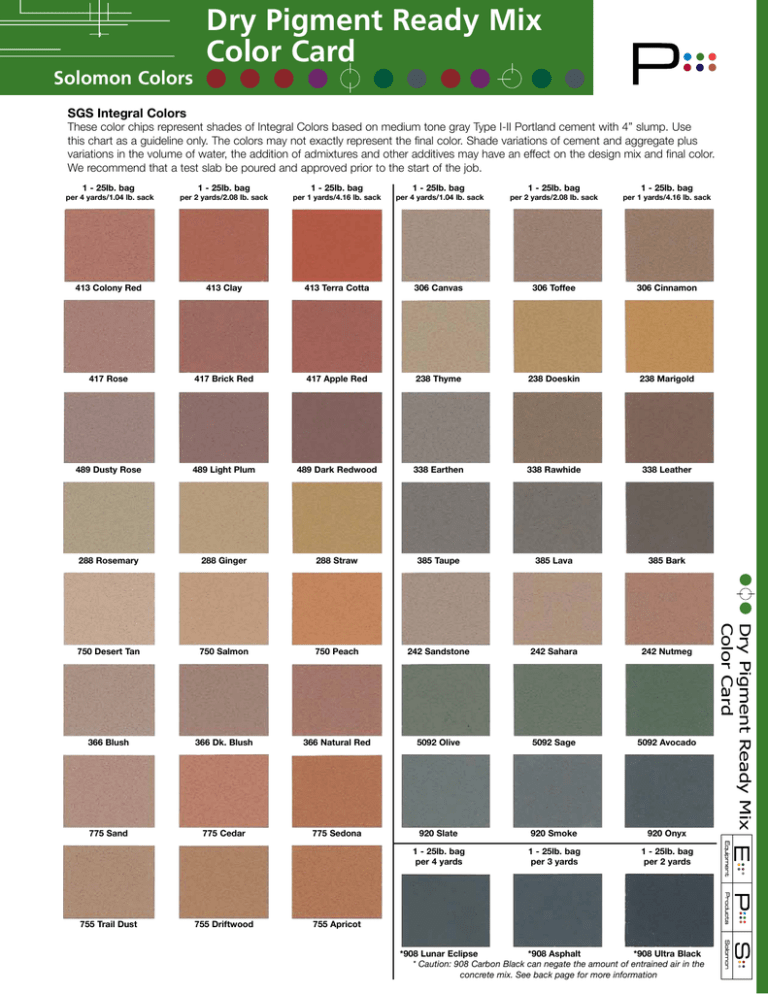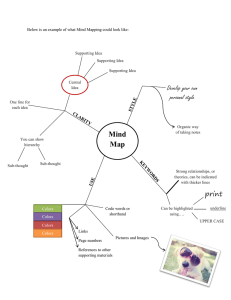Solomon Colors Dry Pigment Ready Mix Color Card
advertisement

Solomon Colors Dry Pigment Ready Mix Color Card SGS Integral Colors These color chips represent shades of Integral Colors based on medium tone gray Type I-II Portland cement with 4” slump. Use this chart as a guideline only. The colors may not exactly represent the final color. Shade variations of cement and aggregate plus variations in the volume of water, the addition of admixtures and other additives may have an effect on the design mix and final color. We recommend that a test slab be poured and approved prior to the start554 of the job. 364 1 - 25lb. bag per 4 yards/1.04 lb. sack 1 - 25lb. bag per 2 yards/2.08 lb. sack 1 - 25lb. bag per 1 yards/4.16 lb. sack 1 - 25lb. bag per 4 yards/1.04 lb. sack 1 - 25lb. bag per 2 yards/2.08 lb. sack 1 - 25lb. bag per 1 yards/4.16 lb. sack 519 413 Colony Red 417 Rose 413 Clay 417 Brick Red 413 Terra Cotta 417 Apple Red 306 Canvas 130 432 238 Thyme 575 306 Toffee 306 Cinnamon 186 238 Doeskin 238 Marigold 7475 489 Dusty Rose 489 Light Plum 489 Dark Redwood 338 Earthen 285 201 338 Rawhide 338 Leather 275 288 Rosemary 288 Ginger 288 Straw 385 Taupe 385 Lava 385 Bark 750 Desert Tan 750 Salmon 750 Peach 242 Sandstone 242 Sahara 242 Nutmeg 366 Blush 366 Dk. Blush 366 Natural Red 5092 Olive 5092 Sage 5092 Avocado 775 Sand 775 Cedar 775 Sedona 920 Slate 920 Smoke 920 Onyx 1 - 25lb. bag per 4 yards 1 - 25lb. bag per 3 yards 1 - 25lb. bag per 2 yards 755 Trail Dust 755 Driftwood 755 Apricot *908 Lunar Eclipse *908 Asphalt *908 Ultra Black * Caution: 908 Carbon Black can negate the amount of entrained air in the concrete mix. See back page for more information Dry Pigment Ready Mix Color Card Solomon Colors Dry Pigment Ready Mix Color Card Integral Colors For Ready Mix IRON OXIDE PIGMENTS The use of iron oxide colors in concrete has grown to be the single largest application for this type of pigment. This increase in usage has created a demand for better technology and quality control throughout the concrete industry. Mixing • The drum must be cleaned, and approximately two-thirds of the mix water and one-half of the aggregates needed should be added to the drum, then add color pigment at charging speed. Do not use reclaimed slurry water or reclaimed aggregates. • Solomon Colors integral colors are packaged in 25 lb. white repulable bags. Slit the bag along the top dotted line and completely remove the top portion of the bag. Also slit the bag where the dotted lines are located and dump the bag into the mixer. Mix at high speed for a minimum of 10 minutes. • When using small or smooth rounded aggregates, do not add the bag to the truck, add only the color pigment. In sand-blasted or exposed aggregate finishes, open the bag and pour all color into the truck. • Mixer should be loaded to a minimum of 40% capacity to ensure good color dispersion. • Be sure to use the same mix design and maintain a consistent water to cement ratio throughout the job. • After pour has begun, adding water to the load to improve workability often causes color variation. Additives • DO NOT use calcium chloride. This product can cause discoloration in the form of light and dark areas in the finished product. Non-chloride accelerators, including hot water are acceptable accelerators. • Check the synergy of the mix design (plasticizers, water reducers and air entraining products) with the addition of color by pouring a test slab to confirm the preferred results. Job Preparation Good drainage and compacted aggregate add many benefits to decorative concrete. Pouring concrete over an inconsistent sub-grade or mix of dirt, plastic, wood, asphalt and existing concrete will not cure evenly. These types of sub-grades will force the majority of water to the surface to evaporate, causing efflorescence in those affected areas. In hot conditions, dampen the sub-grade before each pour to keep moisture in the concrete to allow better hydration. Keep the sub-base moisture consistent throughout the day without allowing the water to pool. Jobs requiring a Vapor Retarder and job sites having high heat and low humidity conditions are exceptions to pouring over plastic. Pouring concrete directly over plastic can lead to numerous problems including excessive bleed water, uneven drying time, shrinkage, cracking and efflorescence. Consider adding 2"-4" of sand between554 plastic and concrete. If pouring directly over plastic, mix design may need to be altered. Slump and placement techniques require tighter tolerances, and finishers need to be well trained and experienced. 519 For Vertical Applications (cast-in-place or tilt-wall): All forms should be cleaned thoroughly prior to use or reuse, and applied release agents should be non-staining. For best results, forms should be free of cement latents from any prior concrete pour of a different color. Also, vertical wood forms should 130 be made of medium-density overlay plywood. For color uniformity, methods and material used in preparing the forms should be consistent through the completion of the job. Lightly and uniformly sandblastng vertical surfaces is highly recommended to remove minor form marks and any colored residue resulting 432 from water, cement and coloring agents bleeding toward the forms during concrete placement. Curing • Do NOT fog or spray water on the surface 7475during the initial curing period. • Do NOT cover the surface with plastic. • Failure to follow these guidelines can lead to uneven curing and coloration. • Solomon Colors recommends one of the following Curing Methods to be unitized: 1)BRICKFORM or LEGACY branded CURE AND SEALS that meet the ASTM Standards C 309 and C 1315 for curing most new colored architectural concrete flatwork. Apply at a rate of 250-300 sq. ft per gallon (6.13-7.36m2 per liter) once the slab is hard enough to be walked on without marring the surface. Do not apply these products in high heat, direct sunlight or in windy conditions. Please reference the appropriate cure and seal Technical Information Sheet for a full description of the product use, limitations and precautions. Links to these sheets and additional coloring information are available at www.solomoncolors.com. 2)If you desire to only Cure the surface without a Sealer, use Lythic Day 1. Approvals include ASTM C156 Water Retention Test, reduces water vapor transmission per ASTM F1869MVER and reduces the amount of water vapors that emit through the slab per ASTM D4263 for power troweled colored concrete. After 28 days we recommend a sealer. • Proper curing, along with maintaining a low slump and protecting the surface against water penetration, reduces the possibility of efflorescence. If efflorescence does occur, remove efflorescence using Brickform E-Etch or Legacy Eco-Etch. Follow with a light scrubbing or The use of a low r.p.m. rotary scrubbing machine. TECHNICAL SPECIFICATION DATA Composition and Materials: Pigments utilize pure red, yellow, and black synthetic iron oxides. 364 SOLOMON COLORS has expanded the color range by formulating laboratory controlled high tinting strength blends. Each of these colors is 95% to 99% minus 325 mesh particle size. SOLOMON COLORS iron oxides are permanent, inert, stable to atmospheric condition, sunfast, limeproof, and free575 of deleterious fillers and extenders. All SOLOMON COLORS pigments comply with ASTM C979 for integrally colored concrete and are produced and tested to an established plant standard. Limitations 186 A level of 7% (by dry weight) color based on the weight of total cementitious material used is the color saturation point. Color added in excess of 10% (by dry weight) can reduce the overall strength of the finished product. Conversely, a level of color below 1% can cause irregular coloring and general “washed out” appearance. The suggested 285 “optimum” range is 2% to 4% pigment loading based on total cementitious material weight. *908 Carbon Black Limitations: A level of 2% color based on the weight of total cementitious material used is the color saturation point. Color added in excess of 2% will not provide additional benefits. The suggested “optimum” range is 1% to 2% pigment loading based on total cementitious material weight. (Cement, Lime, Fly Ash, GBFS and other Pozzalanic materials). Due to the particle size of Carbon, it has a tendency to dissipate out of concrete over time. Solomon Colors recommends sealing the concrete with a Brickform or Legacy concrete sealer. It is important to maintain a proper sealer maintenance program to protect the surface color, as this will help slow this process down and in some cases prevent it. Carbon particles will decrease the amount of entrained air during the mixing process. Monitoring air content to specification will be necessary. 201 275 Limit of Warranty and Liability Solomon Colors, Inc. warrants that their product conforms to the description and standards as stated on the product packaging and specific product literature. If properly mixed and applied, Solomon Colors, Inc. warrants the color to be uniform, limeproof, and sunfast. The exclusive remedy of the user or buyer and the limit of the liability of this company shall be the purchase price paid by the user or buyer for the quantity of the SOLOMON COLORS products involved. For more information go to: www.solomoncolors.com www.brickform.com and www.legacycolor.com • CSI 3-Part Tech Spec Sheets available at www.solomoncolors.com & www.sweets.com Scan with smart phone See Us In BRMD180 06/13 4050 Color Plant Road, Springfield, IL 62702, PH: 800-624-0261 • 360 S Lilac, Rialto, CA 92376, PH: 866-747-2656 Email: sgs@solomoncolors.com • www.solomoncolors.com

